The massive headline from this matchup came before the game, not after. Portugal and Juventus star, Cristiano Ronaldo, tested positive for COVID-19, ruling him out for a minimum of two weeks.
While the absence of Ronaldo is a weighty one, Portugal’s depth was on display as Fernando Santos called on Diogo Jota to fill the CR7 void. The Liverpool man didn’t disappoint, recording two goals and an assist in a comfortable 3-0 victory for A Seleção.
This tactical analysis breaks down Portugal’s success in manipulating Sweden’s strong defence, contrasting it to the disconnect in the Swedish attack. With Portugal leading 2-0 at halftime, the second half saw the Scandinavians up their urgency. We’ll examine the change in tempo and the fallout at the end of this analysis.
Lineups
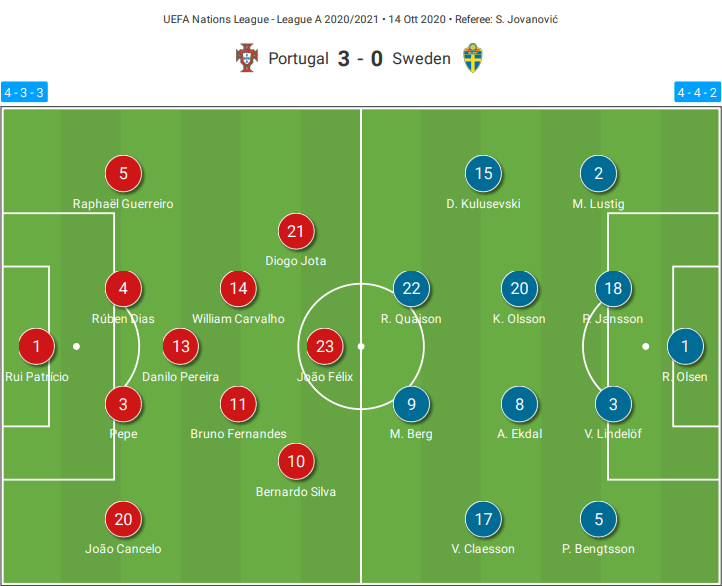
Portugal’s coach, Santos, used his preferred 4-3-3 in this match. Rui Patrício was again the man in goal. Pepe and Rúben Dias were the central pairing at the back with Raphaël Guerreiro and João Cancelo on the wings. Within the three-man midfield, Danilo Pereira was the #6, William Carvalho played box-to-box and Bruno Fernandes was a true #10. Bernardo Silva started at right-forward but often dropped deep into the midfield to facilitate the build-up. Atlético Madrid’s João Félix started at the #9 with Jota up top.
Janne Andersson’s Sweden countered with a 4-4-2, aiming to use a rigid defensive structure to keep the Portuguese at bay. Robin Olsen in goal with a backline of Carl Mikael Lustig, Pontus Jansson, Victor Lindelöf and Pierre Bengtsson. Juventus winger, Dejan Kulusevski and Viktor Claesson operated in the two wide midfield roles while Kristoffer Olsson and Albin Ekdal played centrally. Rounding out the formation, Marcus Berg and Robin Quaison were the two-man strike force.
Portugal disconnects Sweden’s press
One of the fascinating tactical features of this match was the interchanging of the Portuguese forwards and Fernandes. Though Bruno tended to seek out pockets in the right half space, the front four were very fluid. If Fernandes pushed high, Bernardo dropped deeper to help in the early phases of the attack. On the left, Jota often swapped places with Félix and either player would drop into the midfield to create numeric or qualitative overloads. Wide support from Cancelo and Guerreiro, as well as a brilliant performance by Carvalho, saw the Portuguese string together some scintillating spells of football.
As is customary with Santos’ teams, the ability to create attacking opportunities through defensive execution was on display. As we saw in the two matches against Spain and France, Portugal used a man-marking high press throughout the game. With a 14.5 PPDA, Os Navegadores weren’t necessarily looking to use the high press as a vehicle for attacking third wins. Instead, it was a gentle encouragement to the Swedes to make their attack more expansive.
In the build-up to Bernardo’s goal, the frame shows the near-sided man-to-man scheme in place. Just off-screen are two Portuguese players ready to pressure pass into the two unmarked yellow shirts. The pressure of Félix, accompanied by the cover of Jota and Fernandes, forced the long-range pass attempt from Jansson.
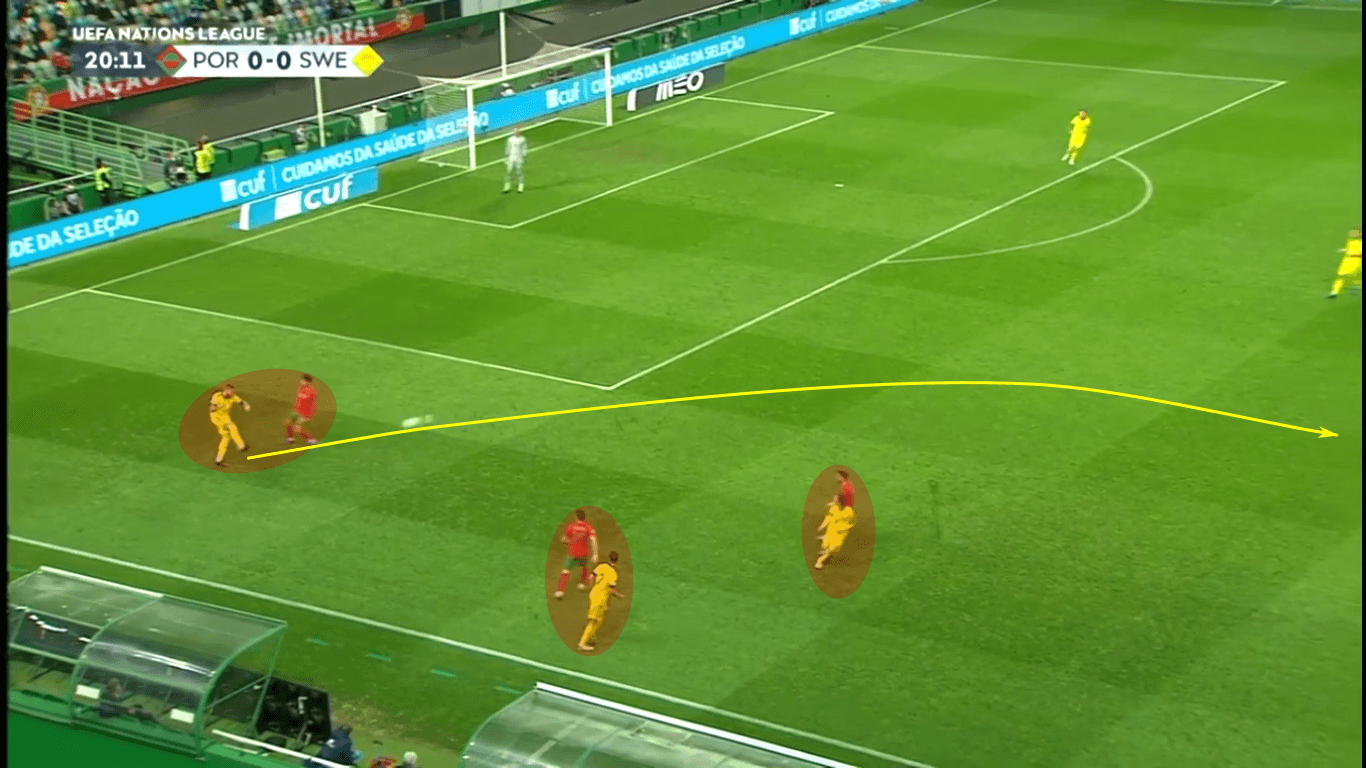
The image below offers a nice visual of Portugal’s tactics. Only Bengtsson, on the far wing, is unmarked. Otherwise, Portugal has a 1v1 or 2v3, plus Pepe as the number up in the back. Dias wins the header, sending the ball to Fernandes’ feet.
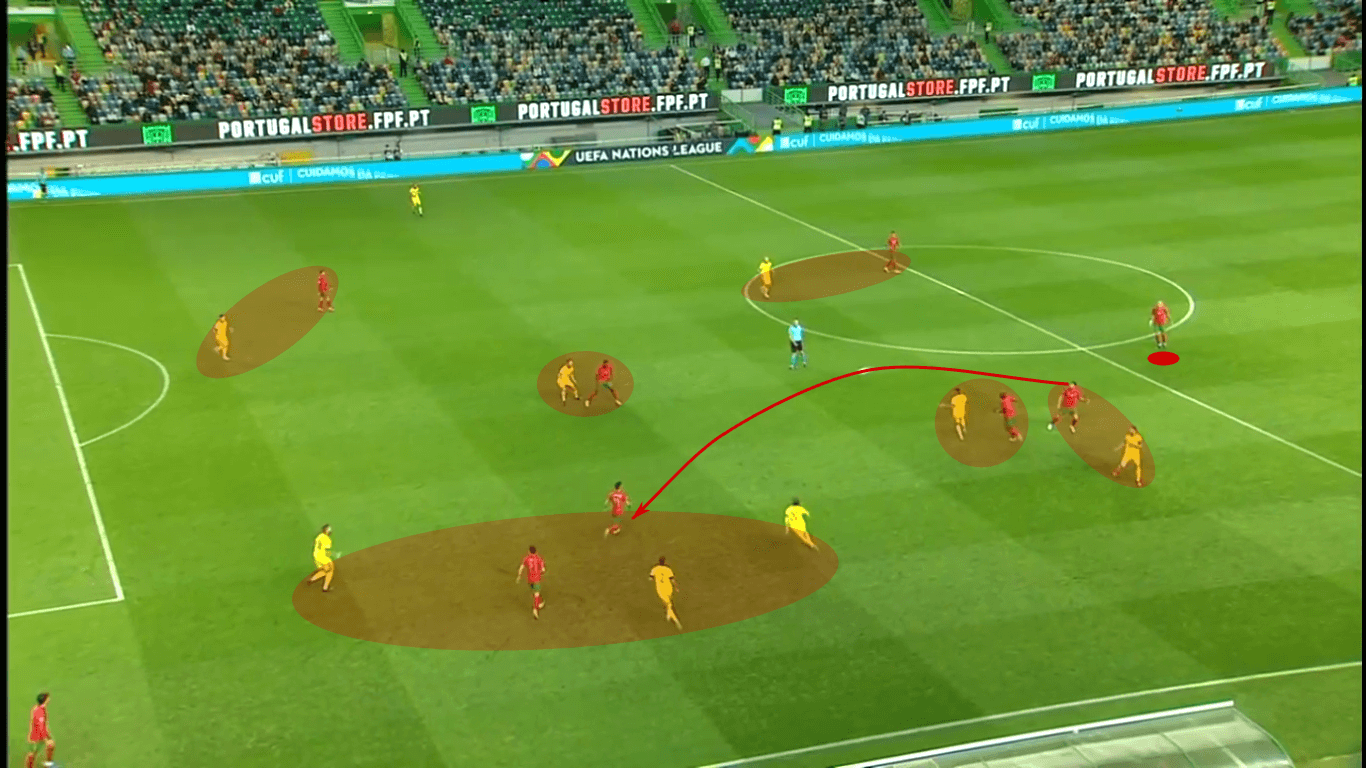
Locked in a 2v3 battle, the Manchester United maestro slotted a clever through ball to Jota. With his pace, the Liverpool man was able to run into the box. Only Lindelöf could catch him at that point, but that required leaving Bernardo.
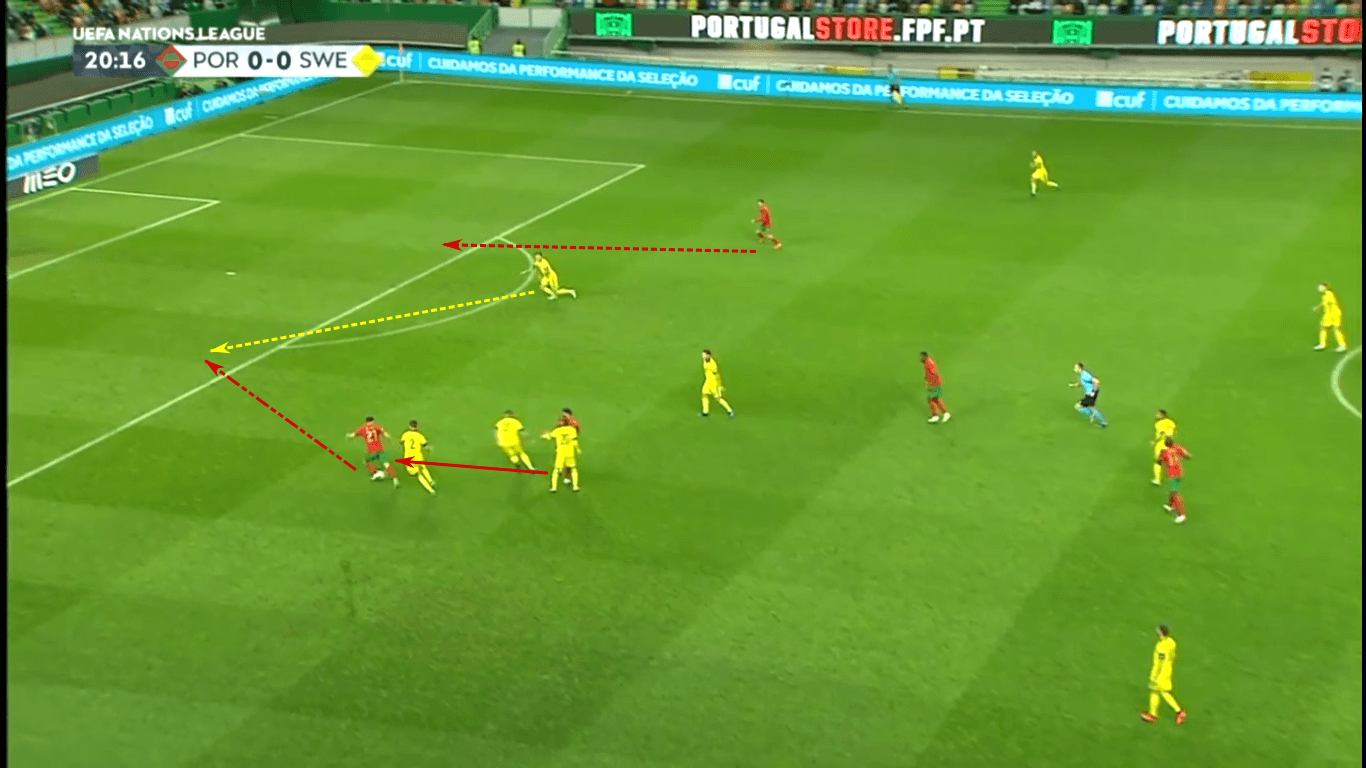
With Lindelöf committing to Jota, he slipped a tidy square ball to Bernardo, who made no mistake with the composed finish.
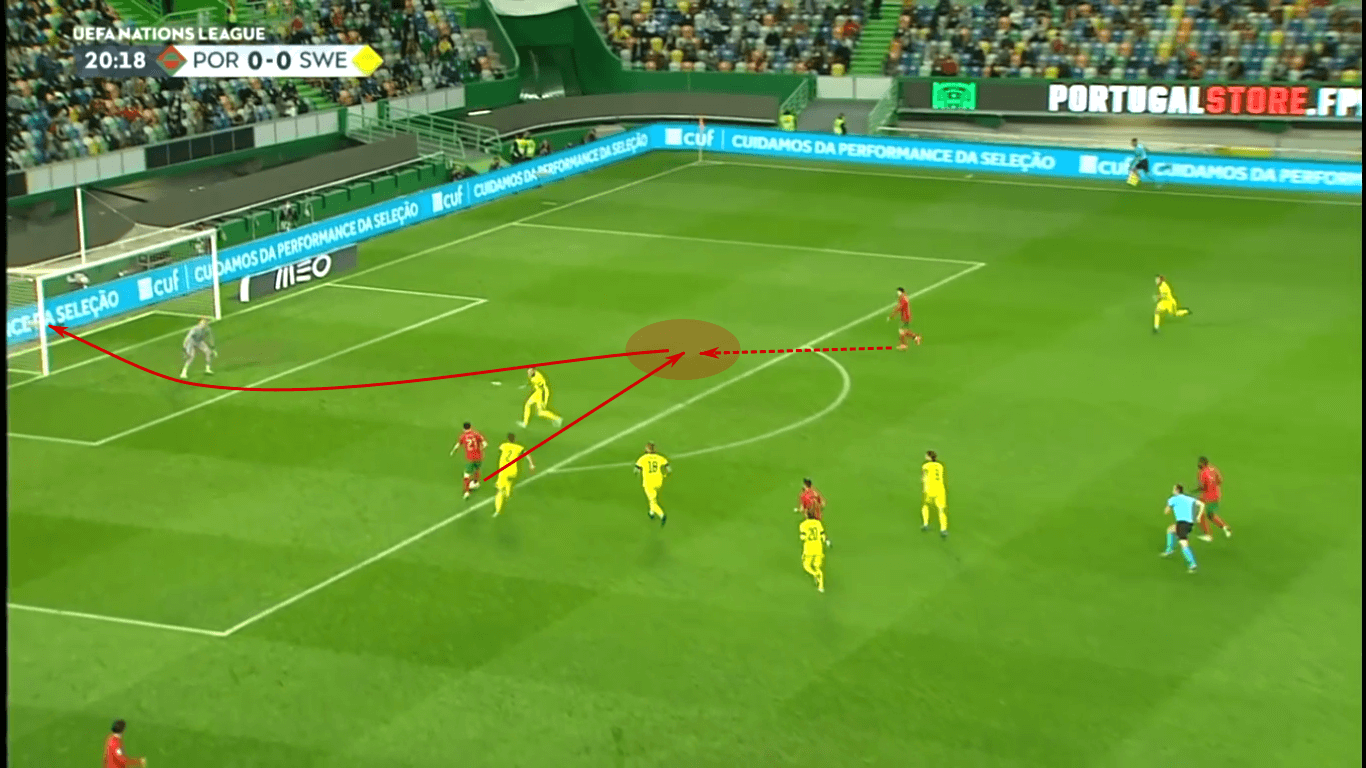
Pivotal to the goal-scoring sequence was the central occupation offered through man-marking in the high press. With the Portuguese players well-positioned to compete for the second ball, the onus was on the backline to win their 1v1 duels and quickly play to the high targets. Pepe and Guerreiro each had 11 interceptions while Dias and Cancelo chipped in another eight apiece.
That defensive dominance gave the players in front of them a great deal of freedom to remain higher up the pitch. Portugal finished the game with 10 counterattacks to Sweden’s zero. That stat is a testament to the excellent rest defence, press and transitions of the Portuguese.
Without Ronaldo in the lineup, the willingness of the young Portuguese attackers to run behind the lines was another key element of A Seleção’s attacking success. Jota’s pace was especially important. As he stretched the backline, larger gaps between the Swedish lines emerged. Fernandes, Bernardo and Félix were the obvious beneficiaries, but The Velvet Tank, William Carvalho, was even more impressive within his role. The Real Betis midfielder went 8/8 on passes to the final third, 2/2 on through balls and provided two key passes.
When Sweden managed to congest the middle and funnel play into the wings, the Portuguese weren’t shy about sending early crosses. As the ball entered the wings, it was common to see the front four drop deep, only to run in behind once the space between the backline and Olsen widened.
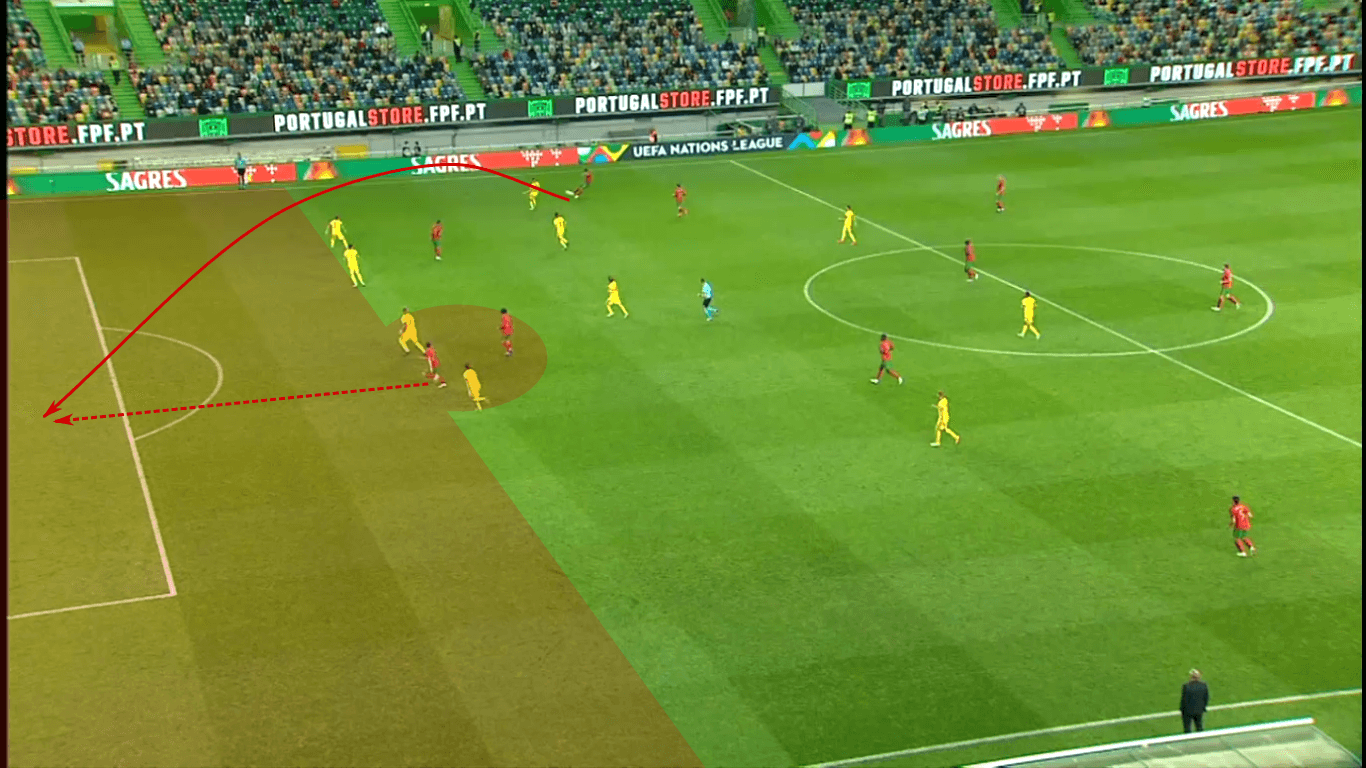
The image above gives a visual of this tactical idea. With Félix and Jota 2v2 in the middle of the pitch, the latter burst into the space behind Jansson. Cancelo picked out his run, sending a perfectly placed early cross into the patch of Jota, who earned his first goal of the night. His pace and direct mentality gave the Swedish defence nightmares. With Sweden forced to acknowledge the creative presences of Bruno, Bernardo and Félix, young Jota had a field day with the space the Swedish defence was forced to concede.
Sweden’s issues in the final third
In a match that saw Sweden evenly split possession and manufacture nine shots, three on target, their best chances came off of two difficult half volleys and long-range shots, both with the feet and head. Those latter chances, while typically coming from quality shots, were low percentage opportunities at best. It’s the two half turns into half volleys that represented the best opportunities. The first came from a corner kick, the other from an effective high press and a nice team move.
Outside of those two higher-quality chances, dangerous opportunities were few and far between. Andersson’s side came out with a very defensive approach, but Portugal’s two first-half goals forced them out of their preferred tactics.
In terms of attacking success, Sweden managed to reach the opposition box 16 times, two more than the Portuguese managed. They even managed to outperform Portugal in the crossing completion stat (38% vs 21%), so you have to ask why they went goalless and lost the xG category 2.44 to 1.16.
Quality in the final pass and shot were obvious issues, but the lack of cohesion and creativity as they prepared to attack the goal were equally troubling. Points of entry into the box typically came from wide positions or when Portugal had numbers behind the ball. Additionally, the absence of more direct players and poor technical execution hurt the side.
For example, the sequence below, which comes just before Jota’s first goal, sees Olsson pick the ball up in the left half space, then drill it forward to Kulusevski, who did well to find space between the lines.
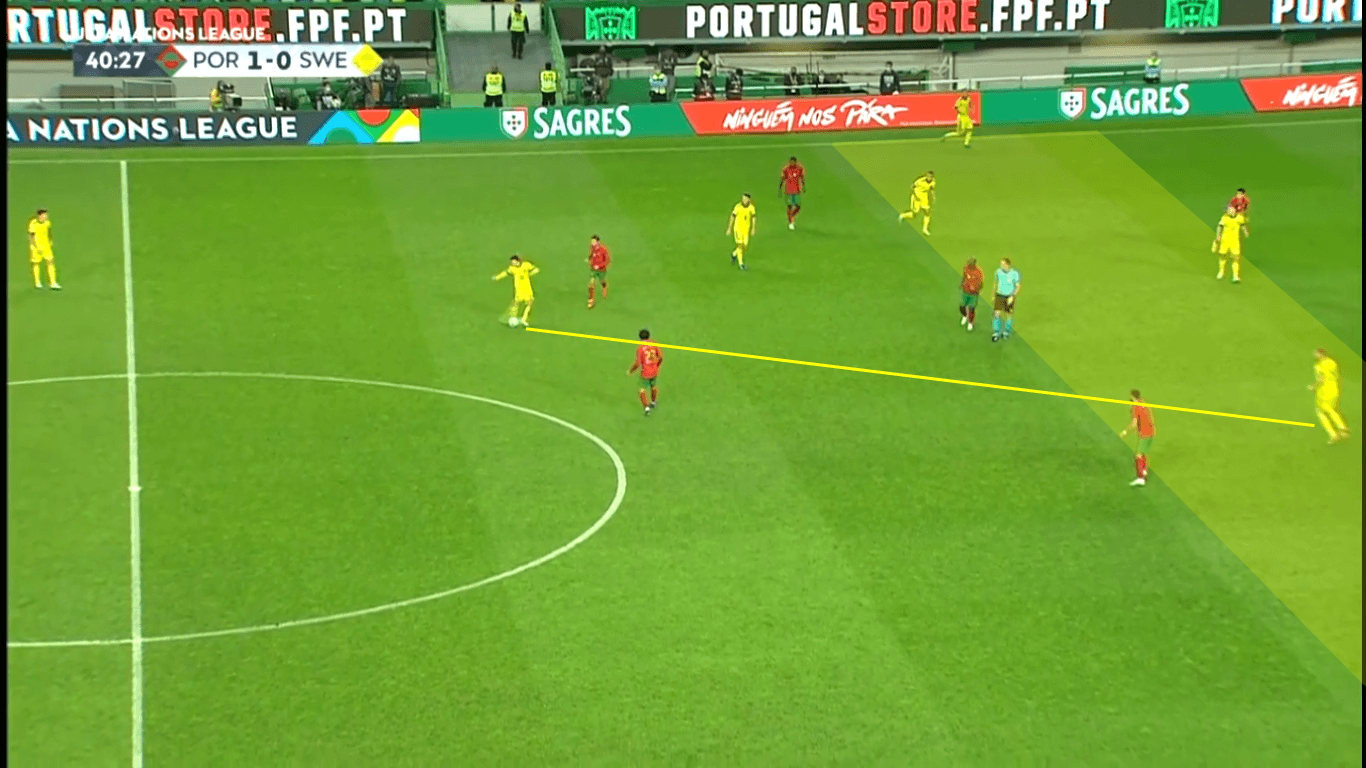
The Juventus winger popped up his first touch. Under heavy pressure from Guerreiro, he dropped to Quaison, who then swung the ball out wide to Bengtsson. Cancelo went out quickly, blocking the attempted cross.
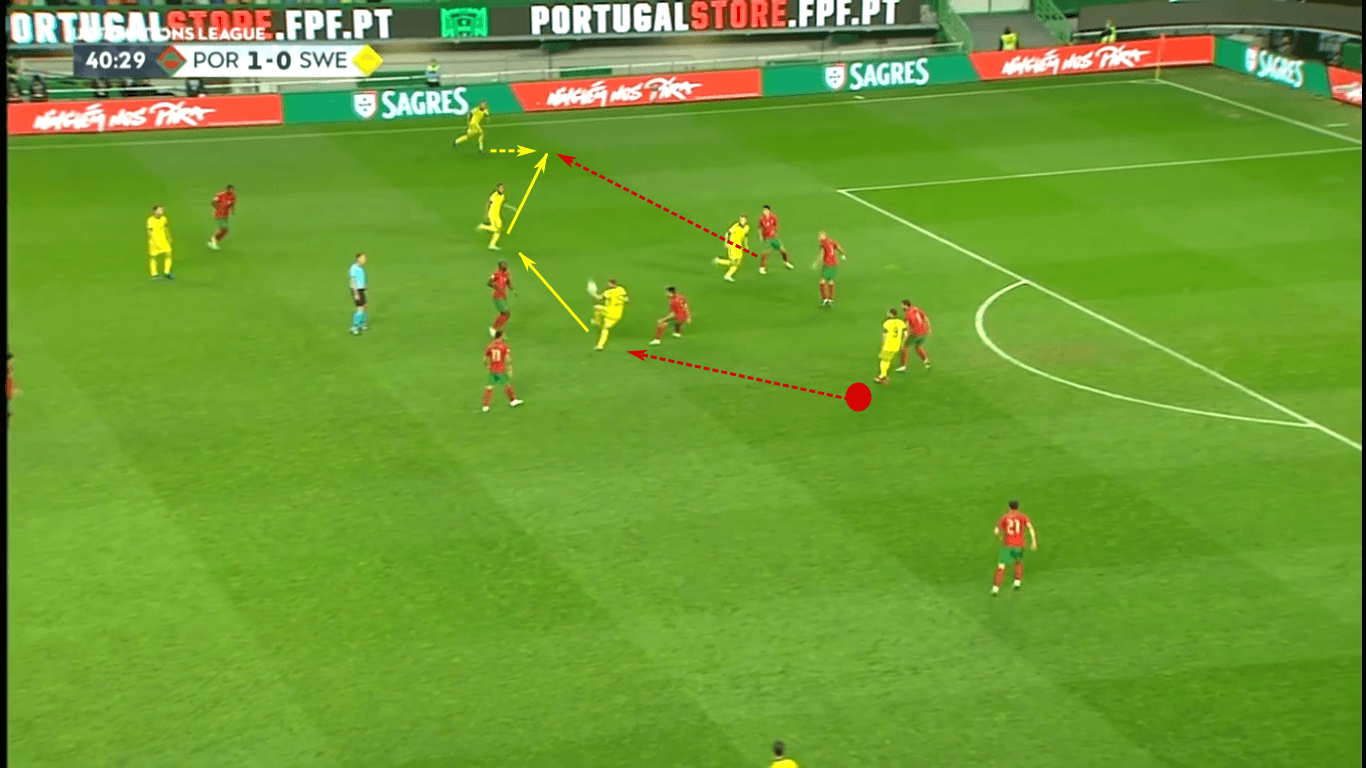
Despite a central 3v4, the oncoming Quaison and the wide presence of Bengtsson, this slow, indirect Swedish attack couldn’t must any kind of threat. It was a common issue throughout the night.
As the game progressed, frustration was certainly settling in. When they finally opened up the attack and tried to get behind the Portuguese backline, timing negatively impacted their success. Of their five through ball attempts, only one (20%) was completed. Perhaps the greater indicator of their attacking frustrations were the 34 positional attacks generating just five shots, leading to a lowly 15% success rate of such attacks. Compare that percentage to the 29% success rate of Portugal and you get a sense of how this match played out.
The image below gives an idea of the passes they were playing in the later stages of the game. Granted, they had just gone down three 13 minutes prior, but this type of sequence was reoccurring in the second half. Alexander Isak, who may very well be the most direct player on the Swedish team, looked to slip Claesson behind the backline. However, the winger’s run started too late, plus he wanted the ball centrally, which was simply too difficult a pass for Isak to complete.
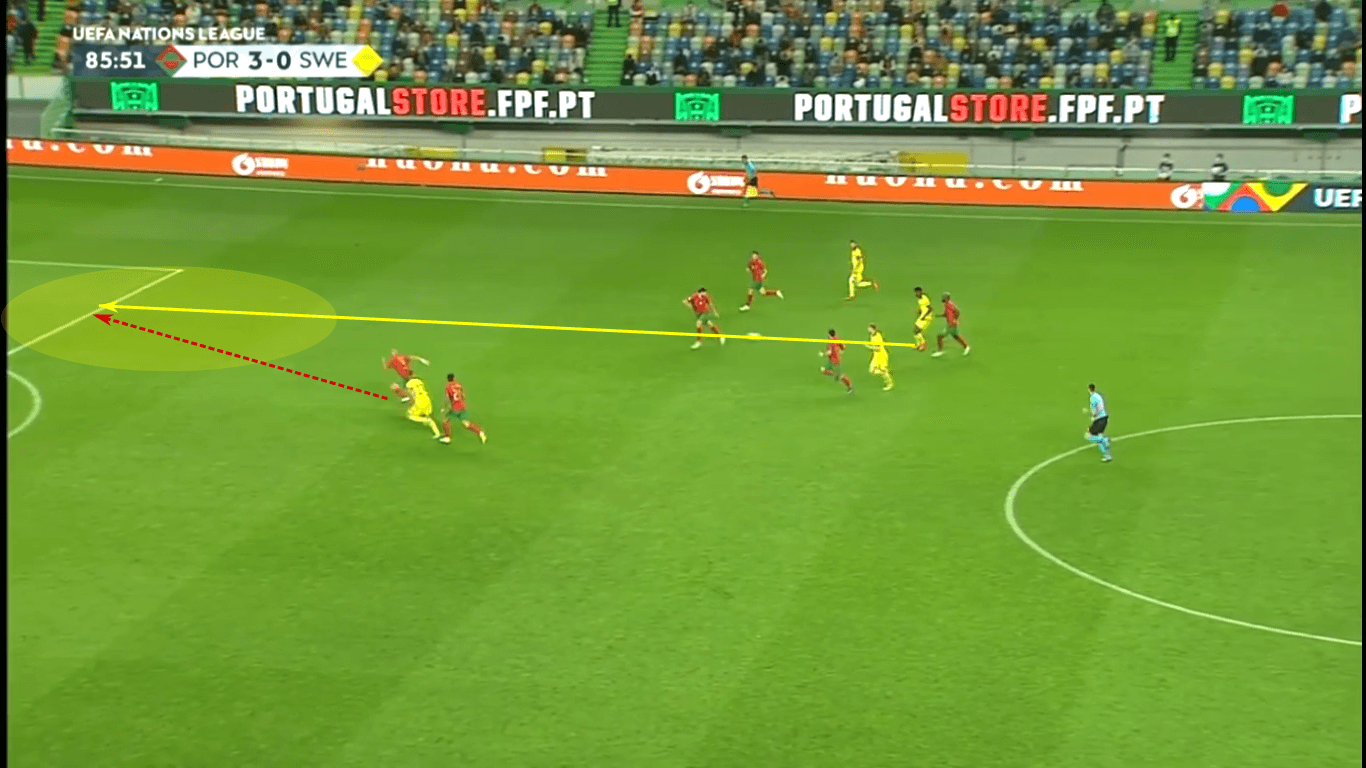
In the end, Pepe emerged with the interception and calmly restarted the attack with a pass to Patrício.
If there is a bright spot from Sweden’s attacking play, it’s the quality of shots they generated from crosses. As mentioned earlier, those headed shots tended to come from longer distances, much like the shot below from 12 yards and a tight angle.
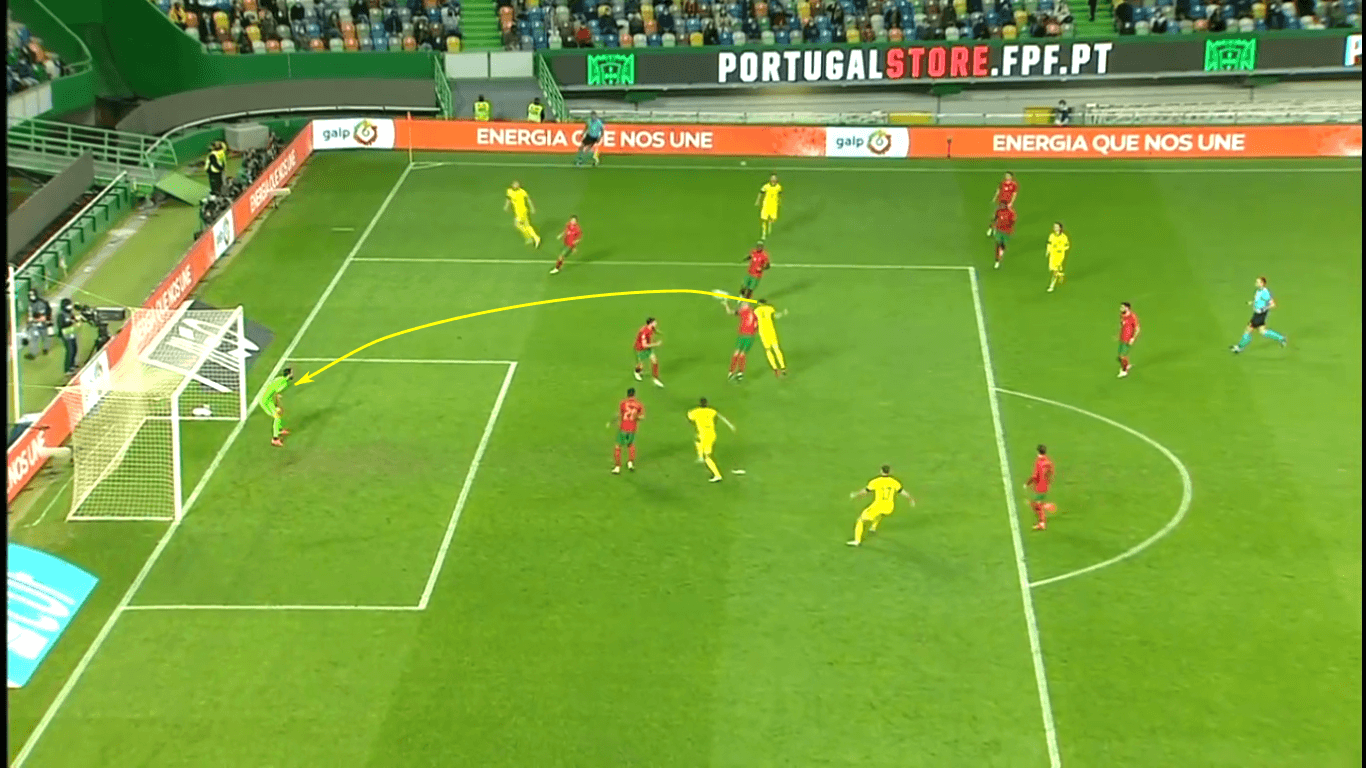
There’s certainly quality in this Swedish side, much more than they were able to showcase on Wednesday. Targeting more dangerous regions of the box will help them moving forward, but they’ll also pick out better delivery points for the crosses if they show greater courage to try the riskier pass in the final third. Compare the high percentage of passes they completed into the box (17 of 30, 57%) compared to Portugal (seven of 18, 39%). Timing and risk-taking certainly favoured the Portuguese in this one. Meanwhile, the Swedes tended to play the safe, predictable pass, much to the delight of the Portuguese backline.
Change in tempo, same results
With Portugal leading by two goals heading into the second half, there was a definite shift in momentum and tactics. Statistics show that Portugal had a 54/46 possession edge in the first 15 minutes of the second half, but the average distance from goal for each action was just 47 yards, significantly lower than the 61 yards from goal Sweden posted. Analysis of minutes 45-60 shows that Sweden reduced the intensity of their press, dropping their PPDA to 12.8, well shy of their 9.3 game average. They forced Patrício and the backline to handle the bulk of the progression duties, preventing line-breaking passes.
Looking at the recoveries maps below, Portugal was much more active in their defensive third during the second half. Meanwhile, Sweden improved their high recoveries from 15% in the first period to 27% in the second. Oddly enough, between the two teams, there’s only a 1% discrepancy between first and second half recoveries in the middle third.
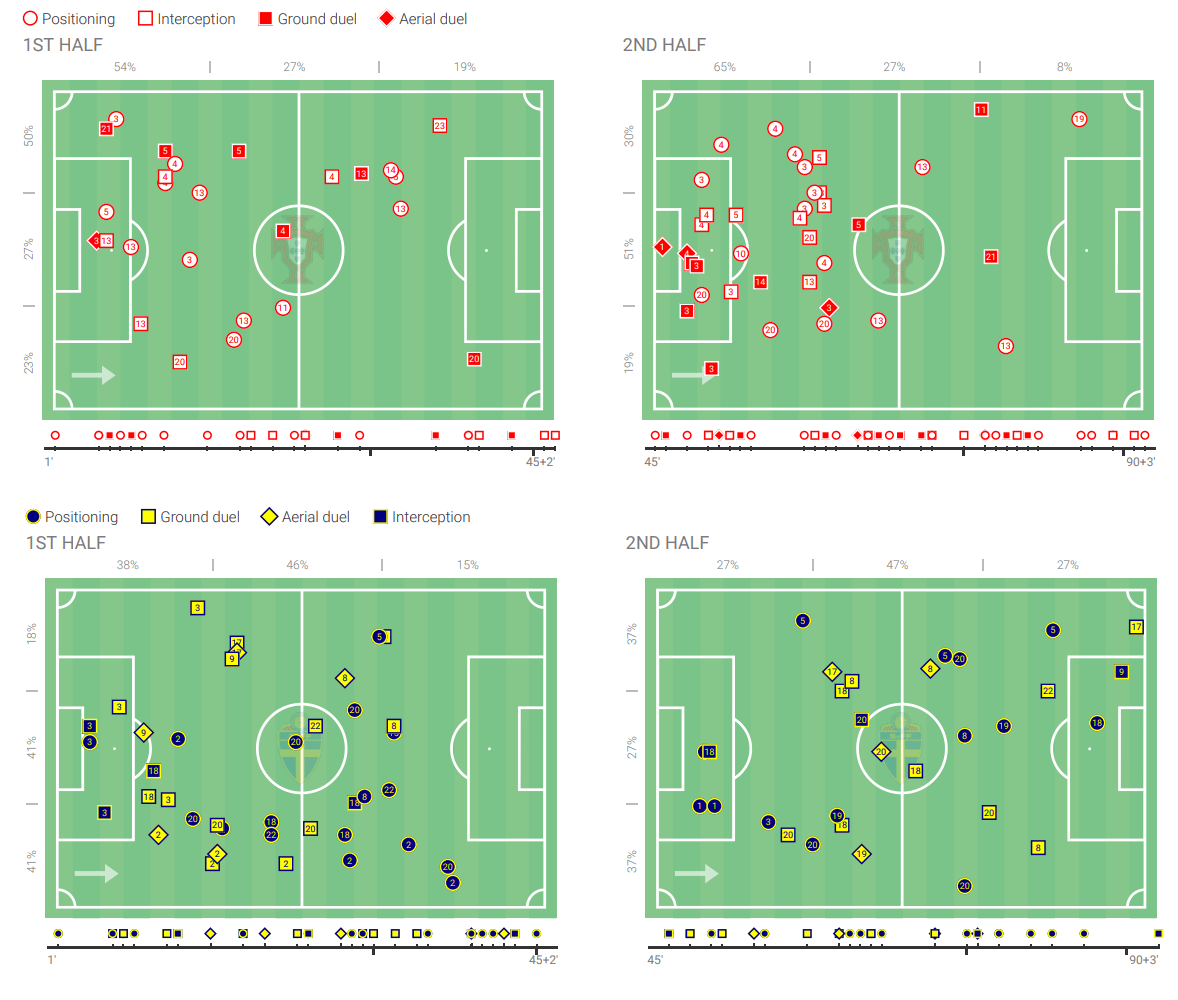
Despite the differences in starting points of areas of play, each team’s attacking tactics from the first half had a high influence in the way the second half played out. Even though the points of recovery changed and each team adjusted their defensive tactics, the attacking tactics remained largely the same.
In Sweden’s case, there was a little bit more of an initiative to play directly, but there was an obvious disconnect when that happened. The side looked most prepared to work the ball into the wings, then prepare for the cross. Of the side’s five second half shots, two came from crosses, two from 20+ yards and the fifth from the top of the box after a chaotic set piece.
The inability to generate open play shots from inside the box was a major issue for Blågult. Even in transitional moments, Portugal were generally well-prepared to deny central access to Sweden. Kulusevski’s shot in the 63rd minute offers a nice example of that transitional engagement.
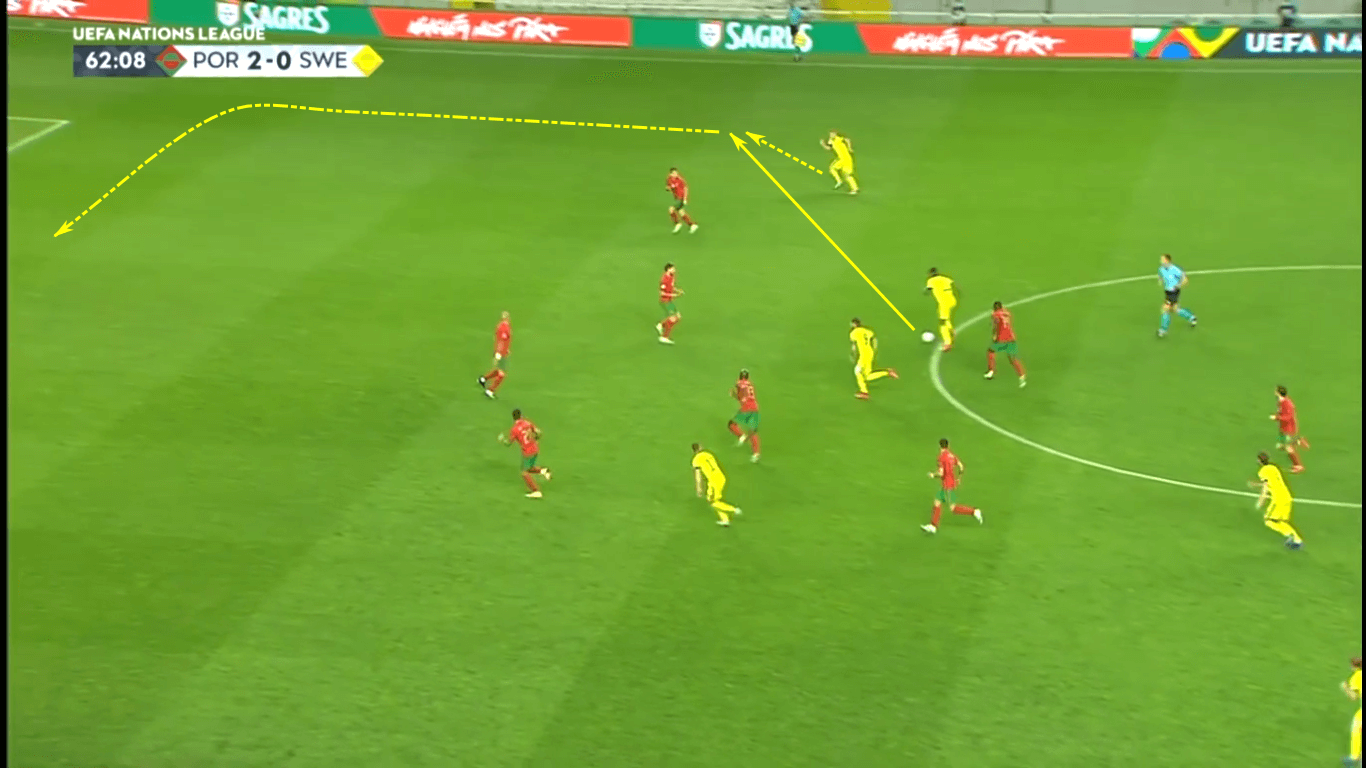
We see above that Isak’s pass is played wide to Kulusevski. With the Portuguese defence +1 behind the ball and two more defenders just behind it, the wide pass to the Juventus winger was the only forward option. Rather than settling for the numbers down cross, Kulusevski tried to forge his own path toward goal.
By the time his dribble leads into a tame shot off frame, Portugal has nine players behind the ball. Further, their width is only about 20 yards from one end of the line to the other. They’ve effectively denied any realistic chance for the Swedes to succeed. If anything, this is where a negative pass, then stretching the width of the pitch would have helped them break up that compact Portuguese block.
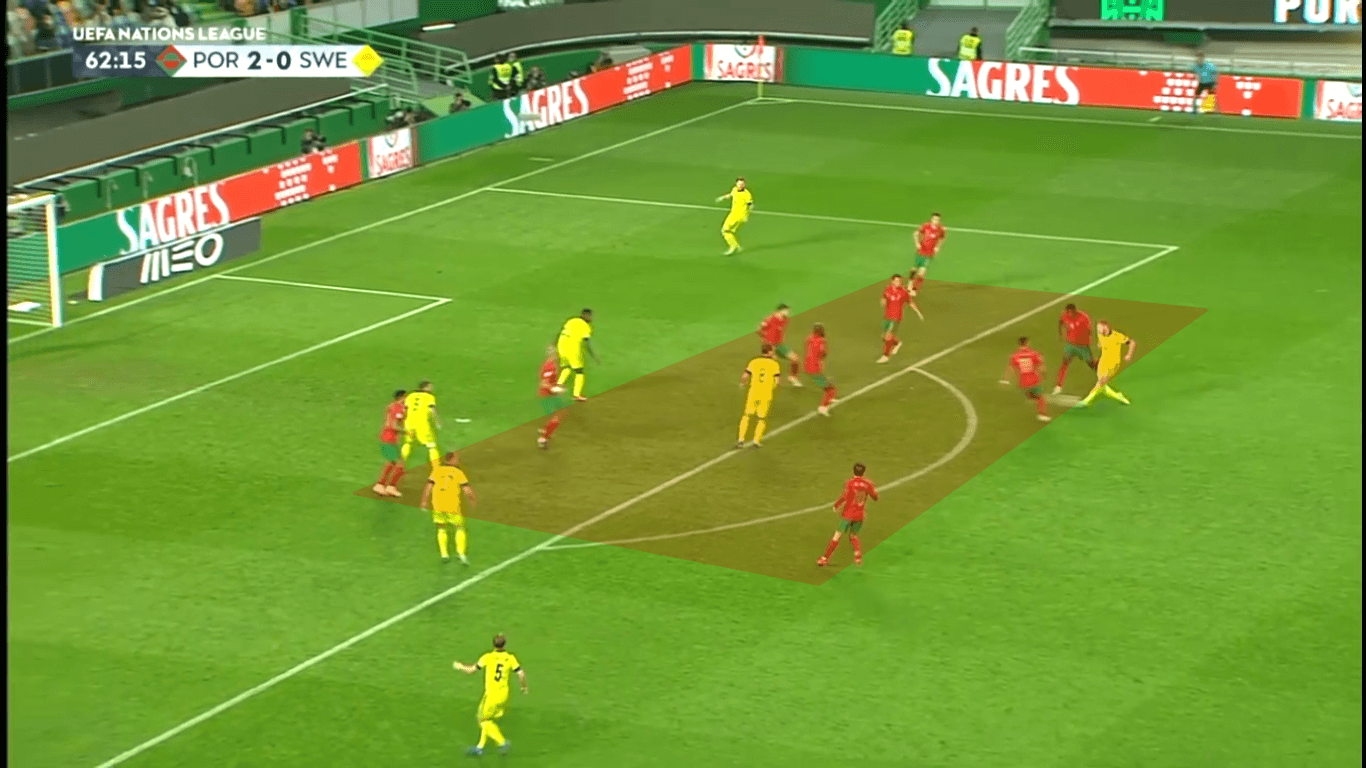
Overall it was a difficult night for the Swedes. Even when they managed to find a little bit of space in the box, like the image below, the quality of technical execution, timing and understanding were missing. In this case, it’s the latter two points that hurt them. Kulusevski wanted the ball at his feet sooner, but Olsson took an extra touch, then led his teammate too far. Bernardo claimed the loose ball, set back to Bruno and the Portuguese transitioned into the attack again.
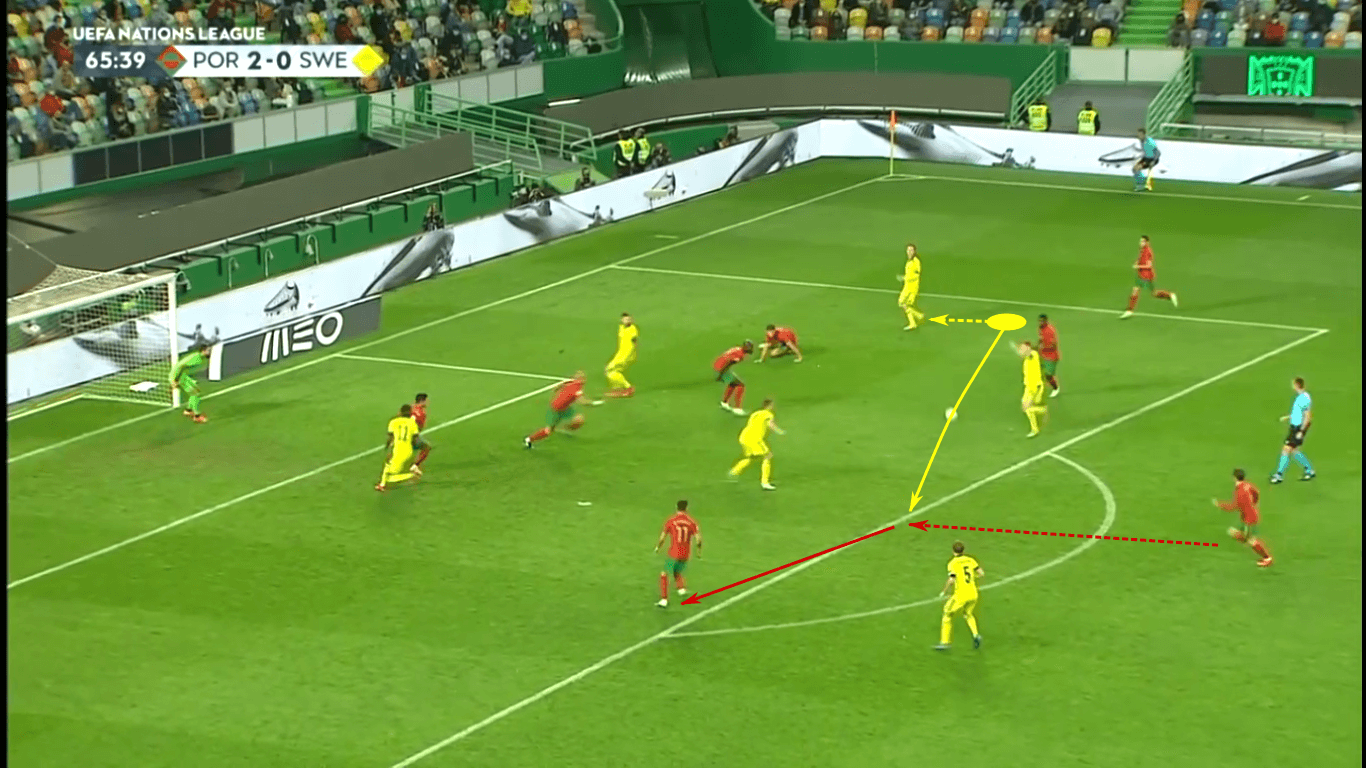
Much like the first half, Portugal experienced a lot of success playing between the lines. With a backline featuring four confident and competent attacking players, as well as the presence of Carvalho in the build-up, the side was routinely able to draw up the Swedish high press, then break the lines to the play in the gap.
Portugal’s 10 counterattacks were already mentioned, but it’s an analysis. After the Portuguese press forced Sweden into a long-range pass attempt, Renato Sanches drifted into the massive space between the lines, gambling that his side would win possession and find him.

The gamble paid off, allowing Sanches to run directly at the backline. With the pacey Rafa Silva in front of him, Sanches held the ball long enough to allow Rafa to get outside of his defender, which pulled Jansson away from the middle. Once the gap emerged and Rafa was at full speed, Sanches played the Benfica forward behind the line. If not for a poor touch in his approach to the shot, he may very well have secured a fourth goal for his side.
One of the other counterattacking opportunities Portugal targeted was actually a response to Sweden’s counterattacks. As the Scandinavians aggressively pushed forward, Portugal would look to play forward quickly, breaking the press and giving the higher players a chance to progress in more attractive numerical states.
The sequence below shows Pepe winning possession in coverage of Dias.
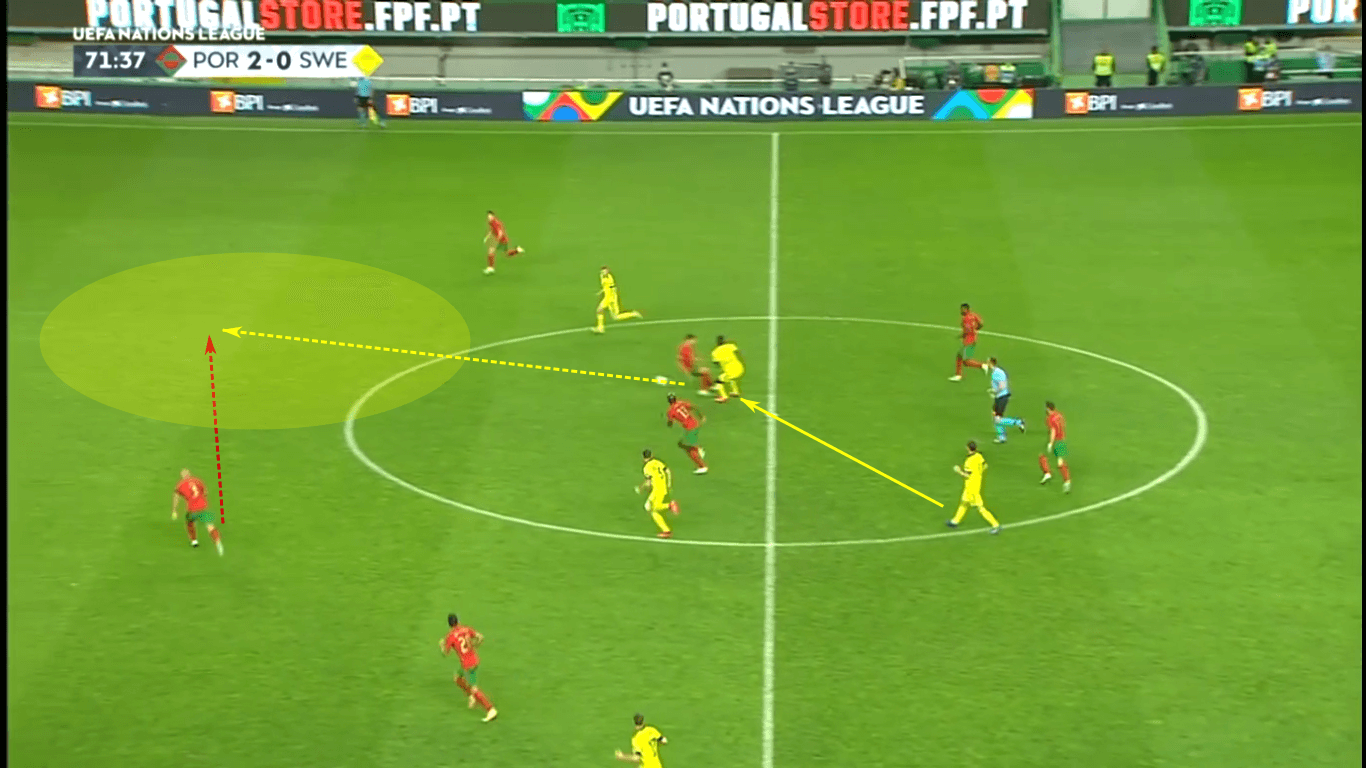
After shrugging off the defender, the Porto centre-back immediately played forward to Carvalho. The former Sporting Portugal man, who knows the Estádio José Alvalade well, gave Jota a running start before playing him behind the line.
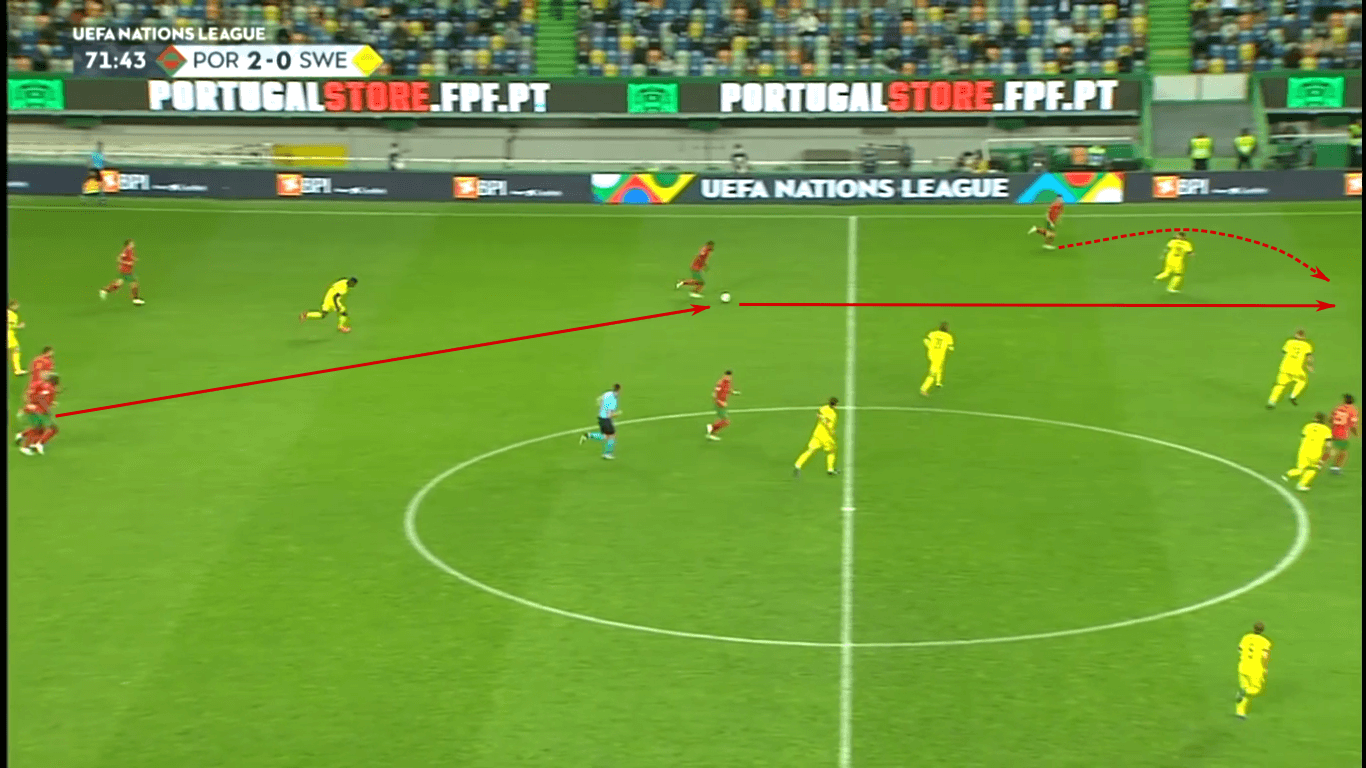
Jota’s individual brilliance secured the goal, but Portugal’s recognition that Sweden was overcommitting to the counterattack in the second half opened up this opportunity. The midfielders were especially effective in recognizing when their teammates were going to win the ball, then immediately making the mental transition to the attack.
Conclusion
With the win, Portugal kept pace with France at the top of their UEFA Nations League group. Further, with the shutout, Portugal have now kept four consecutive clean sheets. Those other three shutouts came against France, Spain and the first leg against Sweden. In four Nations League games, Santos’ side has scored nine and conceded just once. When the tournament resumes in November, they’ll host France in a winner takes all game. Should they draw, Portugal will look to secure passage to the semifinal against Croatia.
The loss leaves Sweden in a difficult place. Four losses in four games doesn’t relegate them to the B League, but they’ll need a win against Croatia to avoid that fate. They’ll host the World Cup runners-up in November before finishing the tournament against the World Cup champions, France, three days later. It’s a tough task for Andersson and his side, one that will require more attacking production than they produced against Portugal. With just one goal to their name and eight against, it’s a tall task for Sweden to avoid relegation.





Comments